How to DIY a Roost for your chickens
If you are looking for tips on how to DIY chicken roost that’s important for the hen’s welfare, then this article is what you need. Get help from the basics and beyond to build the best chicken roost for your coop and take another step towards a flock of healthy and happy hens.
When you start raising chickens, there is so much to learn; this guide will help you to set up a coop that your chickens will love to lay eggs in!
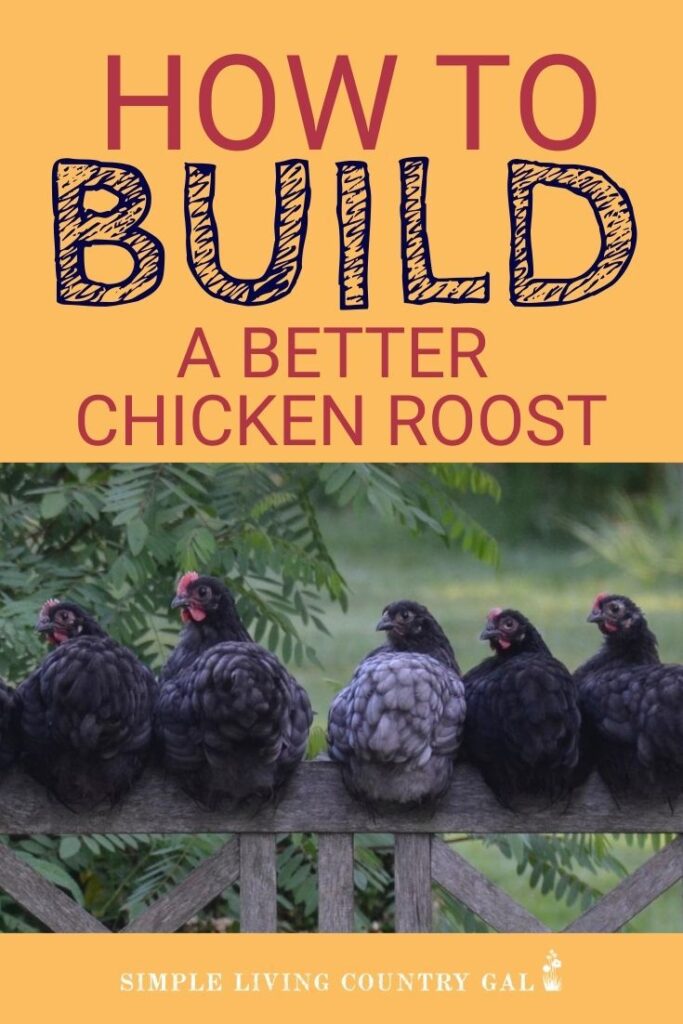
If you have ever gone into a chicken coop at night, you might think your chickens are very sound sleepers. You can easily walk around them and even pick your birds without much fuss. The reason for this isn’t because they are sleeping; it’s because they have little to no vision in the dark.
Since chickens cannot see well at night, they feel safer up off the ground. To help provide a safe sleeping area for your girls, even inside a coop, you will want to have a roost for them to perch on.
What is a chicken roost?
A chicken roost is a platform of sorts where chickens can perch, elevated off the ground. This can be a ledge or a ladder, anything that is not level with the floor.
Chickens have a natural instinct to be safe after dark and will naturally gravitate towards a roost. If they cannot find one, they will look for any place that will give them a sense of safety.
I realized just how important this was one night when we could not find one of our hens. We spent quite a bit of time searching for her, and as the night got darker, I became more worried for her safety.
After a bit, we finally found her perched on a branch in our apple tree. Her natural instinct told her to get up and out of harm’s way. I was so happy to find her safe and sound and quickly returned her to the coop with the rest of the flock.
We have had this happen on more than one occasion, finding our hens roosting in the oddest places. This is something to be aware of if you free-range your chickens.
They will make a home wherever they feel the most comfortable. That can be in a tree, on a fence, or even in the barn on your fresh-cut hay for your goats.
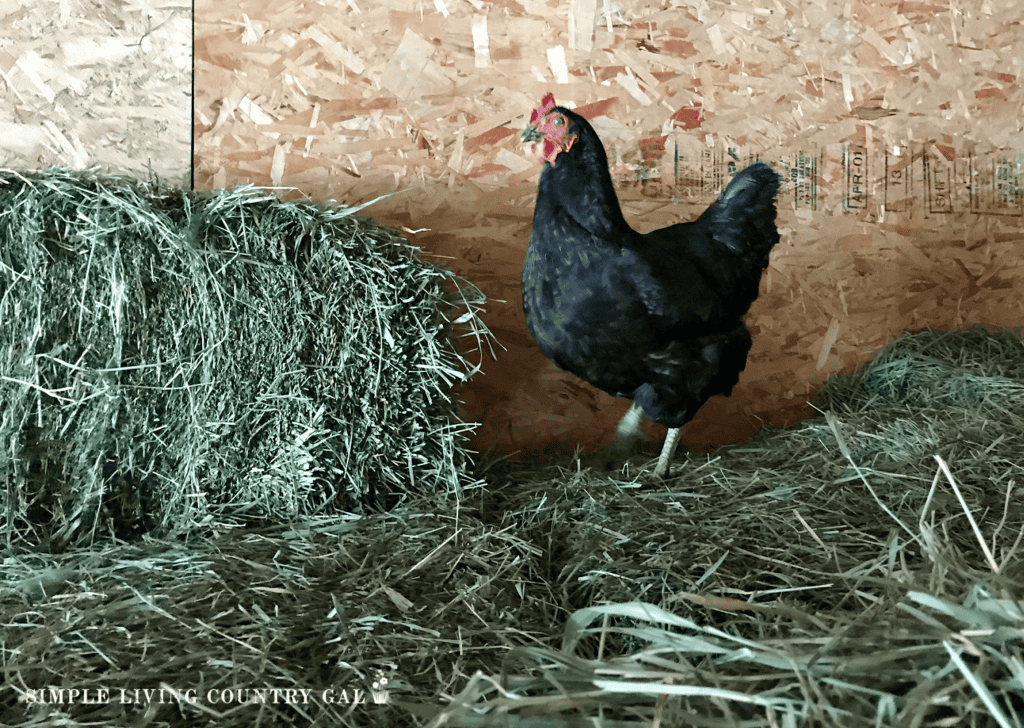
SLCG PRO TIP: If you are free-ranging your birds, teach them to come when called. This is easy to do and something you can train them quite quickly. Each time you are out feeding your chickens, shake the bucket and call to them.
I like to say a few words like “Chick-chick-chick.”
Repeating the same series of words each time you feed will teach your flock that those words mean food is coming. At night, use the same call to bring your chickens back to the coop. Once there you can reward them with a sprinkle of mealworms or chicken scratch.
Training your chickens to come when called can be helpful if you have a missing hen. Walk your yard, shake a bucket of grain, and make your call; you may find a few stragglers running up to you
DIY Chicken Roost Options
Let’s look at a few options that you can use as a roost for your chickens that are easy to make.
Ladder Roost
For years, we used a ladder style as our chicken roost with smaller skinnier boards for the hens to stand on, but I knew I needed to fix what we had. Those ladders although nice, did take up quite a bit of room in our chicken coop. I also later found out that the rungs were not the correct size for our chickens to roost comfortably. (Read more on this below)
Another issue we had was that our flock was growing and needed more space inside of the coop so I decided to remove the ladder roost and find another option.
If you have a small flock, you can easily use the ladder roost in the picture below. It is simple to build and will hold quite a few hens easily.
Another reason I was not a fan of the ladder roost was that it was difficult to clean underneath each morning. To keep our coop cleaner, I prefer to spot clean a little each day, and this was difficult to do with this type of roost.
Here’s a tip if you are new to chickens, they poop….a lot. In order to keep cleanup easier, no matter what roost you choose, you will want to put a board of some sort below them to catch any debris they leave overnight.
I call these “scrape boards,” and they work great to keep a coop cleaner. Each morning, you can remove the boards, take them to your compost pile, and scrape them clean. This will eliminate the smell and mess inside your coop for a longer period of time, allowing you to keep your full coop clean-outs to twice a year.
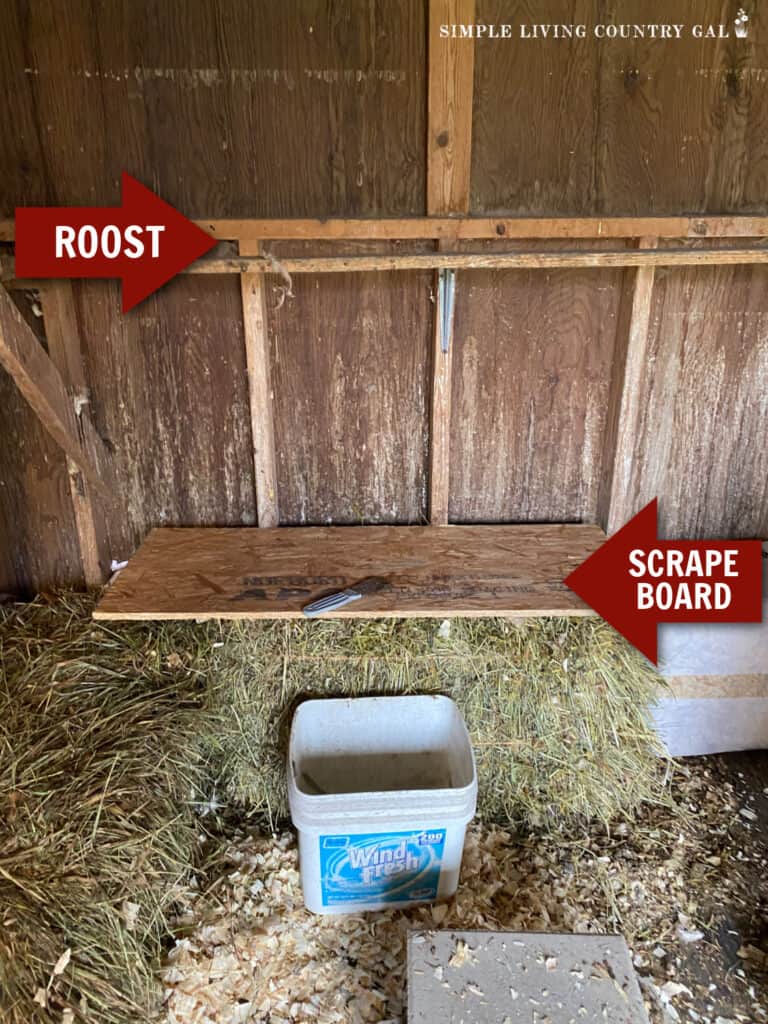
When we had the ladder roosts, I had a small board under each one. Because it was a ladder and there was little room for me to get behind them, I needed to do a bit of tricky maneuvering to get each board out without spilling its contents. This is just something to keep in mind before you settle on a roost design for your setup.
What size is best for the rungs on the chicken roost?
Chicken roost bars or rungs should be at least 2″ wide, but 4″ is better. Unlike most birds, chickens do not use their feet to grip their roosts. They prefer to sleep flat-footed rather than wrapping their feet around the bar or branch.
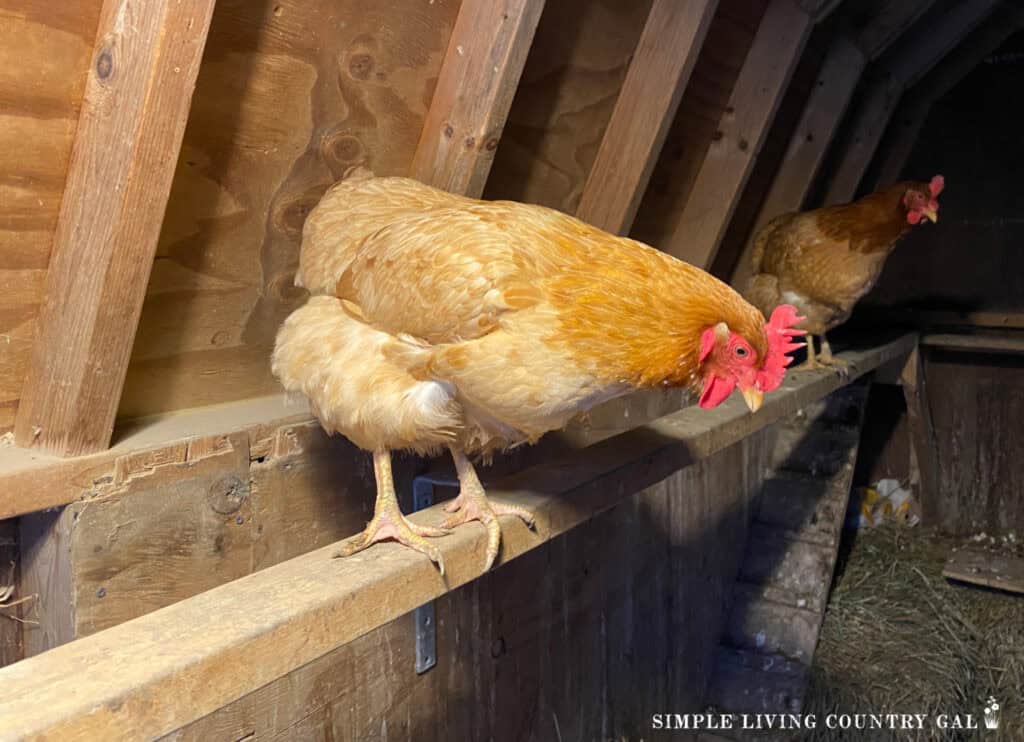
Small Roost Options
If you need a small setup either becuase you are short on space or you only have a few hens, these options will work great.
#1. A step ladder
We used a step ladder for a while, and it was a great solution for the few birds that needed it. The steps are the perfect size for roosting and takes up little space in the coop. Just be sure that it is secure to the coop floor so there is no risk of it toppling over.
#2. Cinder Block Roost
Another option is a 2×4 board set in between two cinder blocks. No, it’s not high up off the ground but it is up enough that your hens will feel comfortable sleeping on it.
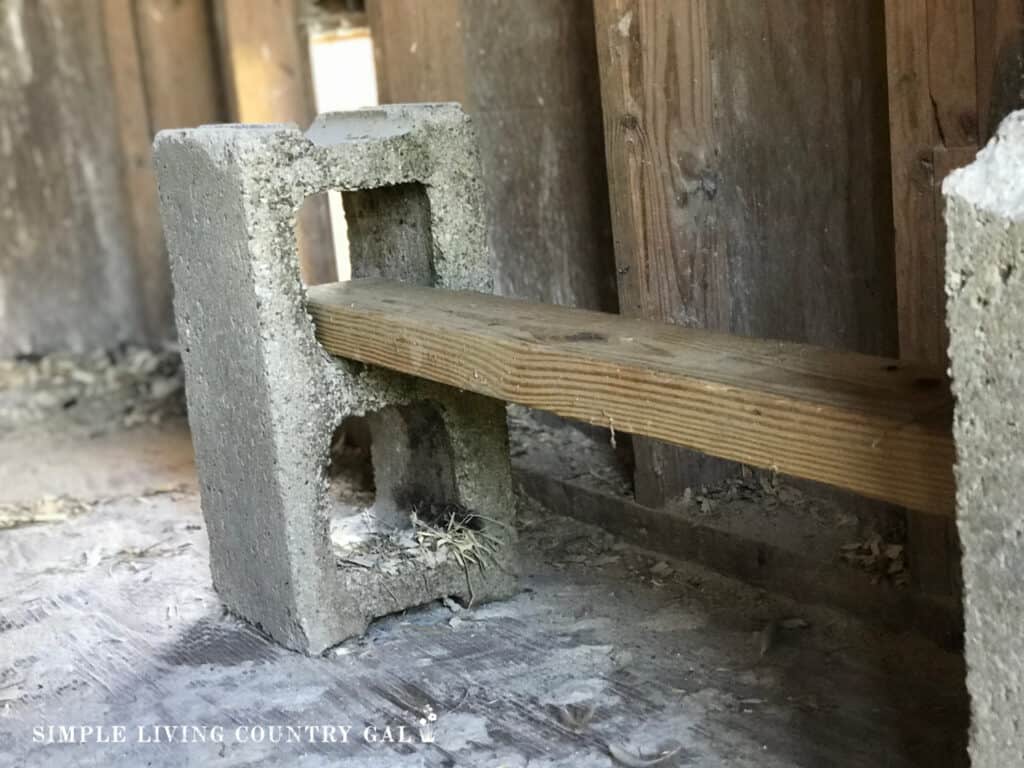
Unique roost options
Sometimes, what is a normal solution doesn’t work as well as you need it to. That is when you call in a unique setup.
#1. Perimeter Roost
You can build a perimeter-style roost if you need more room in your coop. You can DIY this option using scrap wood and a few pieces of hardware.
We used a 2×2 board for the base of our roost, giving our hens a nice wide area to walk and perch on. Once we widened the perch area, we found our hens took to it quite naturally.
Most of our new roost was made with scraps of wood lying around our property. As homesteaders, we always try to reuse items from home before heading out to buy. Repurposing is a large component of a homesteader’s lifestyle. Yes, it may take more work to convert something old into something new, but the money saved is worth the extra effort.
How high should a chicken roost be?
There is no set requirement for the height of a roost. The purpose is to get your chickens off the ground so they feel safe while sleeping. This can be anywhere from 6 inches to 6 feet and will all depend on the room inside your coop.
You can make your roosts at any height; if you choose to do a higher roost, you will want to give your chickens easy access up and down. Since our roost is over 3′ high, we made a ladder made from repurposed materials that we got from the old chicken roost to build a ladder to our new one.
In the beginning, we found many of our hens used the ladder to get up to the roost, but as time wore on and our hens got used to the new layout, they preferred flying up and down rather than using the ladder.
How to Build an Roost Ramp
To build the access roost ramp for the new chicken roost, we used the old ladder roost to create the steps on a board we had in the barn. The runs gave them a bit of security as they walked up the ladder that took them to the top, where we had a small platform for them to turn around on.
Each individual board was screwed onto the mainboard to create steps up the ramp. The ends were then trimmed off, and we filed down any sharp points.
Once finished, we had a ladder-style ramp that the girls could use to gain easier access to the new chicken roost.
SLCG PRO TIP: To encourage our chickens to use our new DIY chicken roost ladder, I sprinkled scratch onto the individual steps. This taught a few to walk up, pecking at grain along the way. Eventually, as with most flocks, the other hens followed the leaders. Today all the hens use the ladder without hesitation.
Finally, the ladder needed to have a landing. Hubby did this to make it easier for the hens to move around once at the top. Since we have quite a few chickens in our coop, ensuring plenty of room for everyone was important. (read more on this below) Remember, the more room you have, the less you will have to deal with bullying and henpecking of smaller and/or weaker hens.
Since we have quite a large flock, we needed our DIY chicken roost to span two sides of our coop. With the little landing, the hens can now climb to the top and choose which way to head off and roost.
How much spacing do you need for your hens on a chicken roost?
When you build a roost, you should try for at least 8″ per hen. In the winter, you will be amazed at how they prefer to snuggle up. In the summer, however, chickens will spread out and use most of the space available. If you are housing a lot of chickens in your coop, you will need a roost that allows for plenty of space for each hen.
If you find some of your hens sleeping on the ground and not on the chicken roost, you will want to find out why. It is either because there is not enough room on the roost or your chickens do not like the setup you have. This was the case for our roost, as it was all on one level. Chickens have a hierarchy that is established on a multilevel roost.
The top hens get the top location, while the lower-ranking hens are at the bottom. In our case, we added a second roost to allow for enough room or another type of roost for the chickens to use.
For our newest chicken roost, we found one hen that refused to use it. Rather than try to force her, I added a small step ladder to our coop. She now prefers to roost on the ladder and is no longer on the ground where she is not safe. Another advantage to having the ladder is our rooster. Some roosters prefer to sleep “below” the hens so they can better keep a protective eye on the flock.
By having the ladder with different levels, our rooster can sleep on the bottom rung, which helps him to feel safe while still keeping an eye on the rest of the flock.
SLCG PRO TIP: If this were a younger hen, I would have worked with her to get her used to the new roost. How to do that is to put her on the roost after DARK (not dusk) when it is easy to pick up and move chickens.
After a few evenings of this, she would have learned the workings of the roost and felt comfortable enough to use it on her own. However, since we plan to sell her in a couple of months, there was no reason to do the training, and the ladder solved the issue without stressing her out.
It is important to know your animals and work with them through reinforced training rather than forcing them to do or learn anything. Once you begin forcing, you will lose the trust of your animals. If you want to train any animal, trust is always the first step, while using food as a positive reinforcement.
Gain their trust no matter what type of animal they are. This trust will make it easier for you to touch them and pick them up, which is necessary for first aid and other hands-on work.
How the pecking order in a chicken flock works. 
As you probably already know, there is a pecking order for chickens, and nowhere is this more evident than on a roost.
Usually, the more dominant hens will be on the highest rungs, with the smaller, less aggressive birds down lower. The trick to keeping things calm and peaceful for your flock is to ensure you have plenty of room for your entire flock to use the roost comfortably.
This is true not only in the chicken coop but also outside in the run and yes, on the roost itself.
More Chicken Care Resources:
For this reason, the ladder-style DIY chicken roost is the most commonly found in most coops. Ladders will give each chicken in your flock a spot to roost safely from predators and other aggressive chickens. If you try the one-level roost that I talked bout above and find hens sleeping on the floor, you can add a step ladder to give everyone a place to roost safely.
Chicken Care Calendar

Where should you place your chicken roost?
You will want to put your DIY chicken roost in the coop area where the weather will not get to them. If you live in a cold area, the wall away from the wind will give you a warmer spot for your flock. If you live in a hotter climate, you may want to put your roost close to a door or window to allow some cool air.
Since we live in northwest Pennsylvania, the cold and wind can be brutal in the colder months, so for our setup, that means our roost is best on the wall that is away from the wind and located as far away from the doors as possible.
Next up, we are going to talk about poo again. You may not realize it, but hens poo when they sleep A LOT. And in the beginning, I was shocked at just how much. Even today, I cannot believe the piles I am greeted with each morning. Keep this little tidbit in mind when you choose your chicken roost location.
As mentioned above, I like keeping a “scrape board” below my roost for easier cleanup. A scrape board is simply a small piece of scrap wood under the roost meant to catch any debris that falls. It is best to clean any scrape boards every morning at chore time. Simply go in and carry your boards as you would a pizza, being sure not to tip it, knocking off your collection of pooh.
Chicken Coop Roosting,Chicken Roosting Bars for Chicken Coop,Backyard Chicken Raising Poultry Habitat Supplies, Wooden Easy Assembly for Backyard Poultry (55′ L x 40′ W)

You can then scrape it into your compost pile or a corner of your garden to be used later. As you scrap the board, take the time to inspect what you are scraping. Runny, slimy, or sticking manure is a sign that a hen is sick and a clue that you will want to investigate further to see which hen or hens are acting off.
SLCG PRO TIP: Do not put fresh manure next to the plants in your garden because it will burn and damage your plants. Let it sit in a pile or your compost bin until it is ready to use.
Another tip is to be sure your scrape board is smaller than the coop’s door. Funny story….the first time I took my scrape board out to clean it off into my compost pile, I walked right into the door frame, and (you guessed it) the board hit me right in the chest with all the pooh and mess.
Not my finest moment.
Having scrape boards will help to keep the coop cleaner cutting down on mites and other bugs, not to mention the smell. Remember, a clean coop will keep your chickens healthier, and promoting good health is much easier than treating a sick chicken or flock.
With our newest roost, I found my hens did not sleep facing into the center of the coop. This surprised me a bit, seeing that they preferred to roost facing the back wall. So when I saw our new ladder invention covered in poo that first morning I was pretty surprised to see it.
After a bit, I realized this was a “good thing.” That ladder now doubles as a scraping board and gathers up the mess nicely from the previous night. Although my hens do use the ladder to get up to the high roost, they do not use it to get down. So, there is no worry about them stepping in piles of poo the following morning.
Why is the chance of chickens stepping in pooh such a big deal? Dirty feet can lead to dirty eggs and the risk of dirty yolks if not cleaned properly. For that reason, always try to keep the coop clean so the eggs, in turn, stay clean. I cut a “V” in a plastic bucket to clean the ladder. This “V” allows the bucket to fit up snugly with the ladder making scraping from each rung much easier. Less falls on the floor, meaning more mess leaves the coop.
No matter which scrape board you use, a paint scraper this one is one tool you will want to have in your coop.
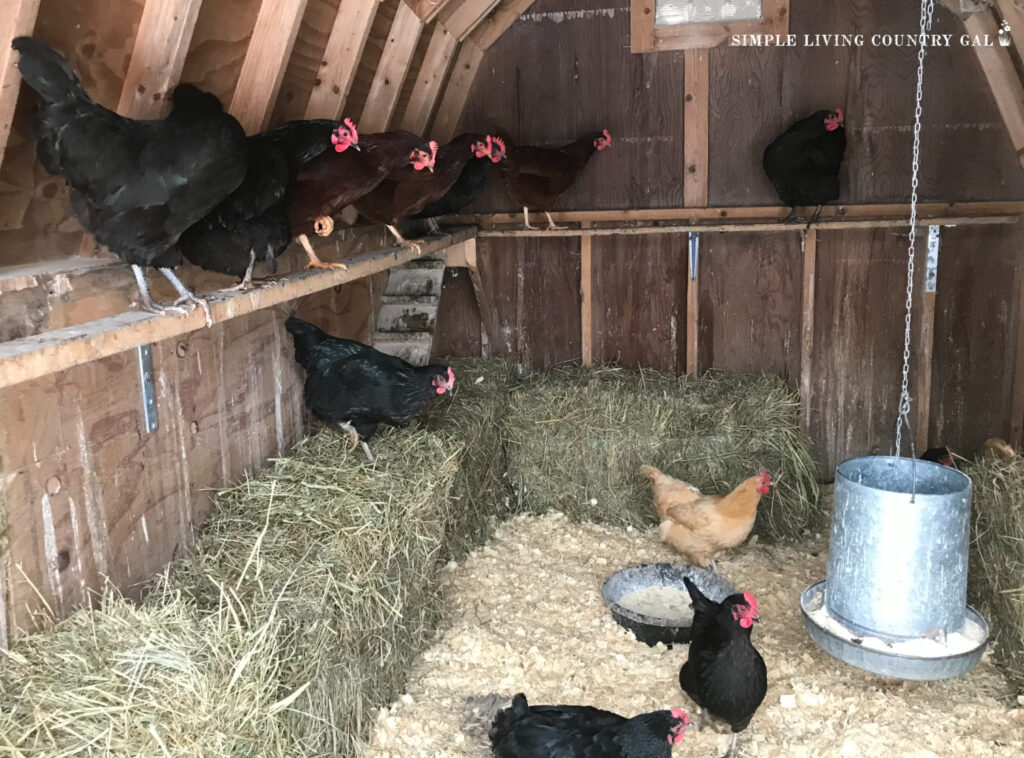
With so many families trying their hand at homesteading, raising chickens is a wonderful way to start. If you are new to chickens, you will need more information besides setting up a roost.
Backyard Chickens 101
Yes, a lot goes into raising chickens, but once you have an idea of what they need and how to keep them safe and healthy, you are good to go.
Read the above articles for a good overview, and you won’t be caught off guard.
Chickens are a fun way to add livestock to your home and a great learning tool for children. Do your homework and ask questions to prepare for a long and happy relationship with your hens. As with all animals promoting healthy livestock through safe and clean housing and healthy fresh food and water is the best approach to raising chickens that lay loads of eggs.
Do you have a DIY chicken roost in your coop? Leave me a comment; I would love to hear from you!
More Chicken Guides:
- How to Convert a Shed Into a Chicken Coop
- Adding a Rooster to Your Chicken Flock
- Self Sufficient Chicken Coop
Read this article and more on the Homestead Blog Hop!
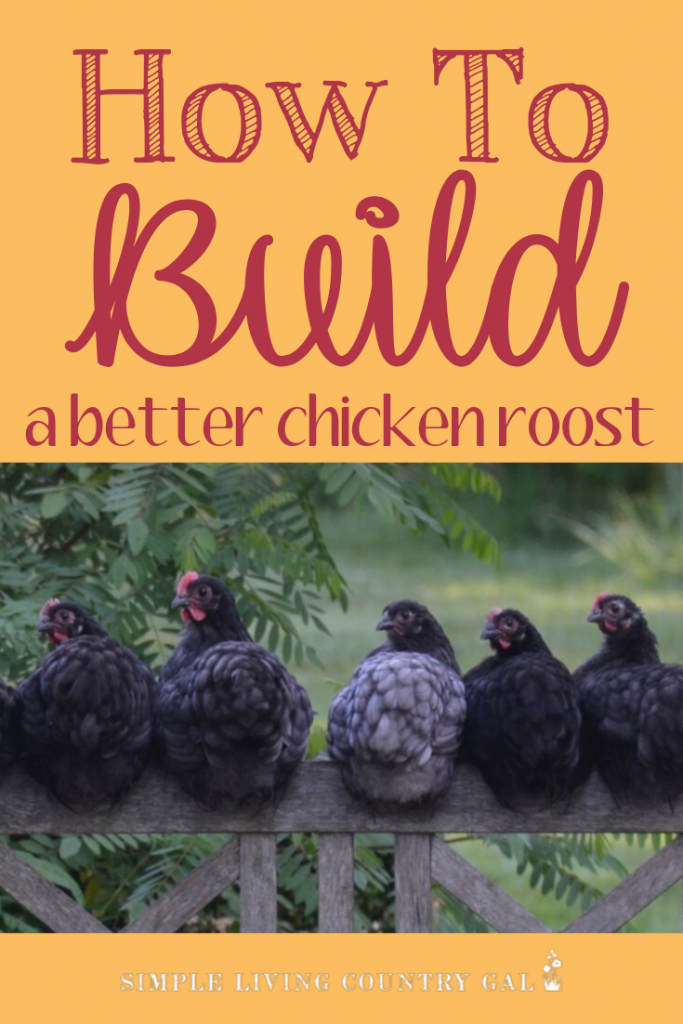

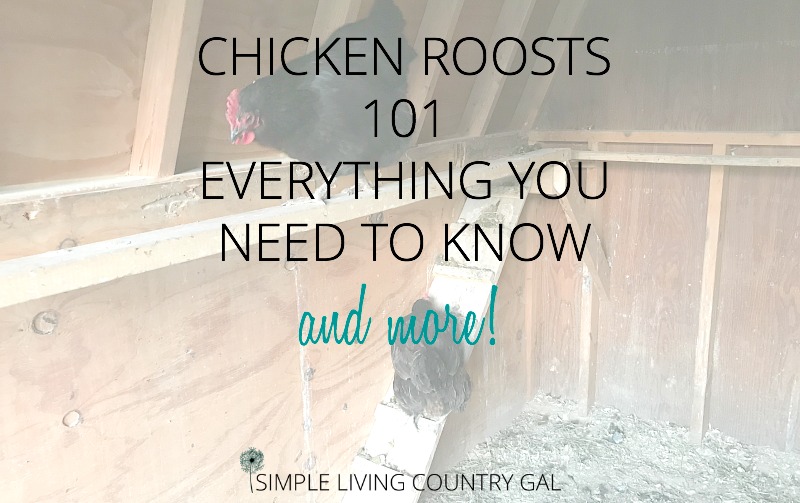
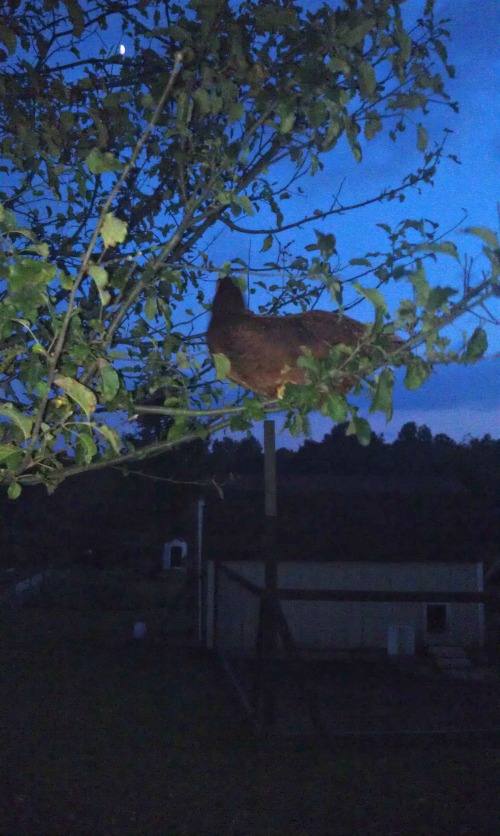
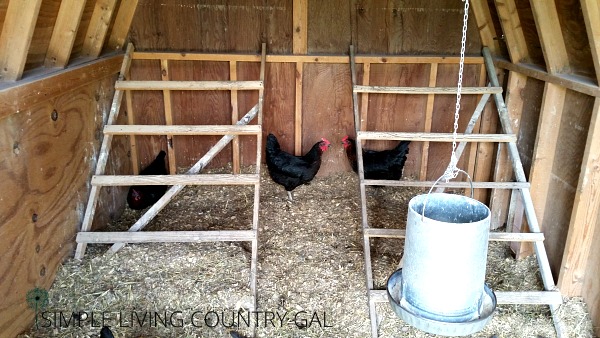
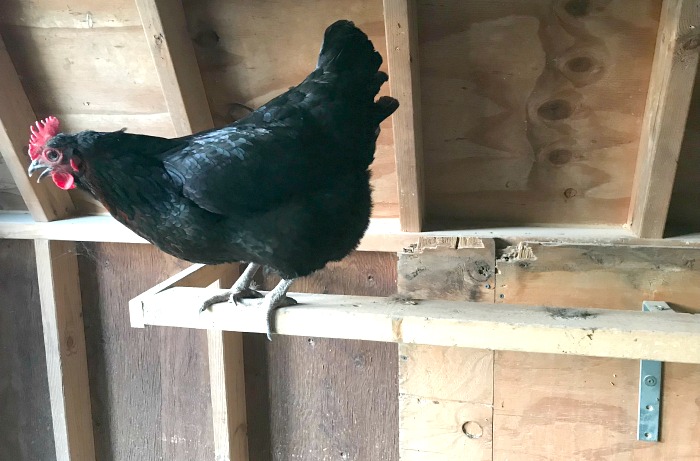
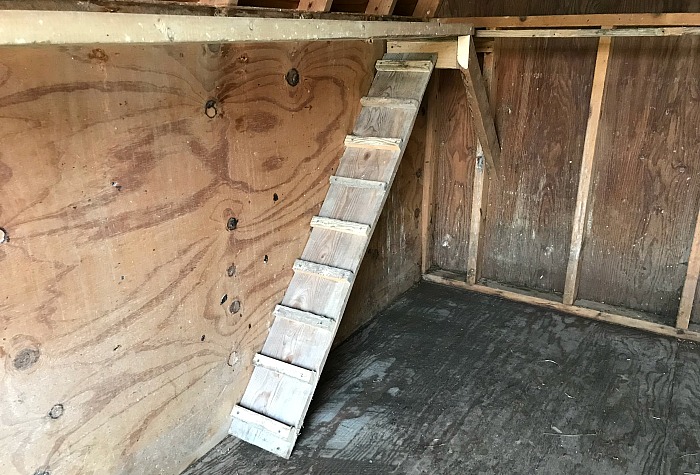
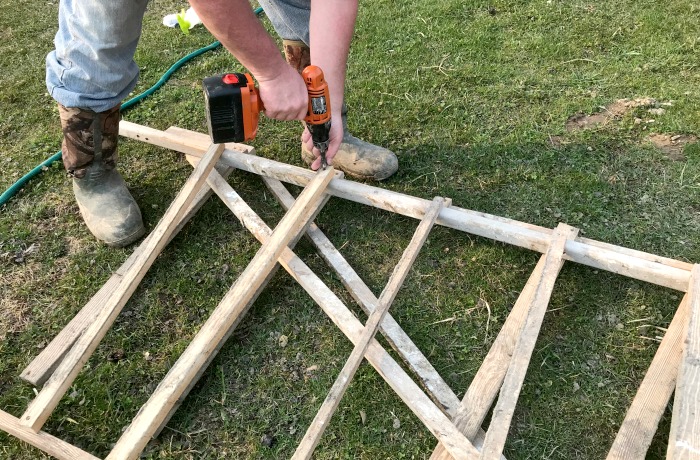
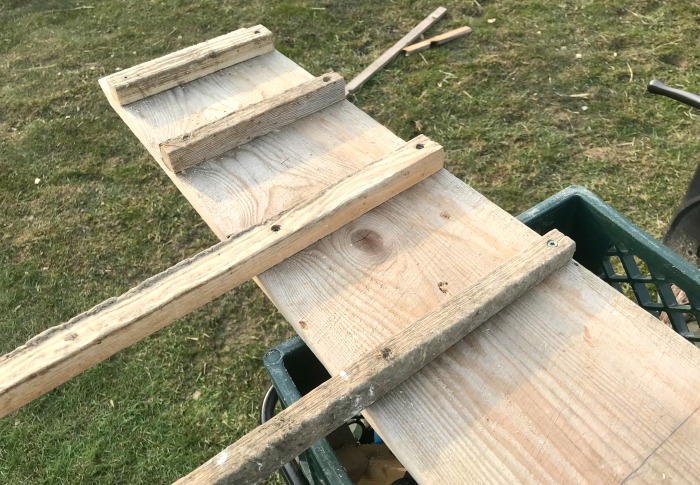
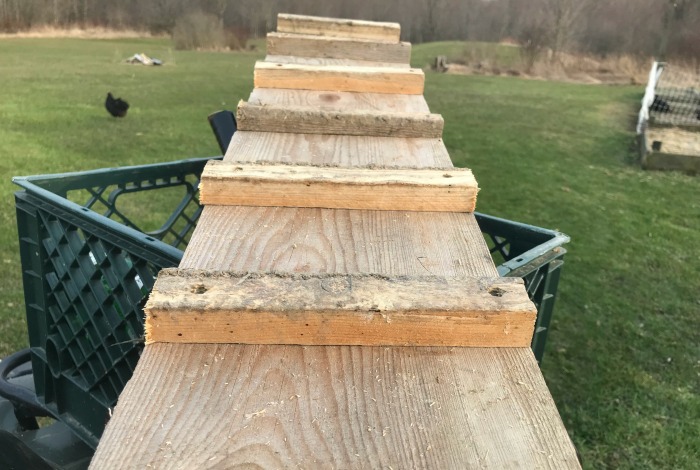
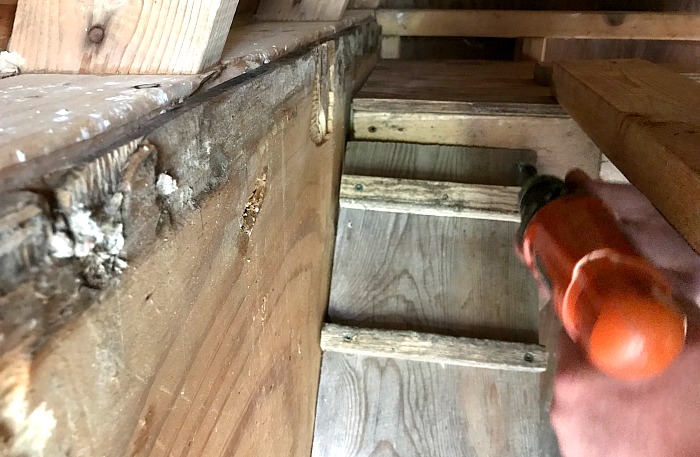
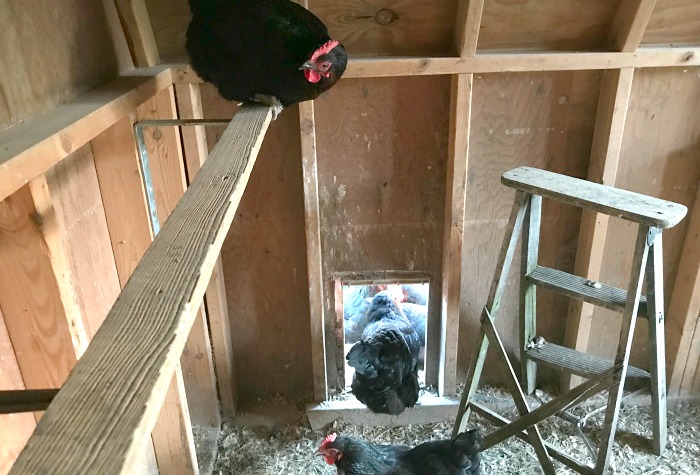
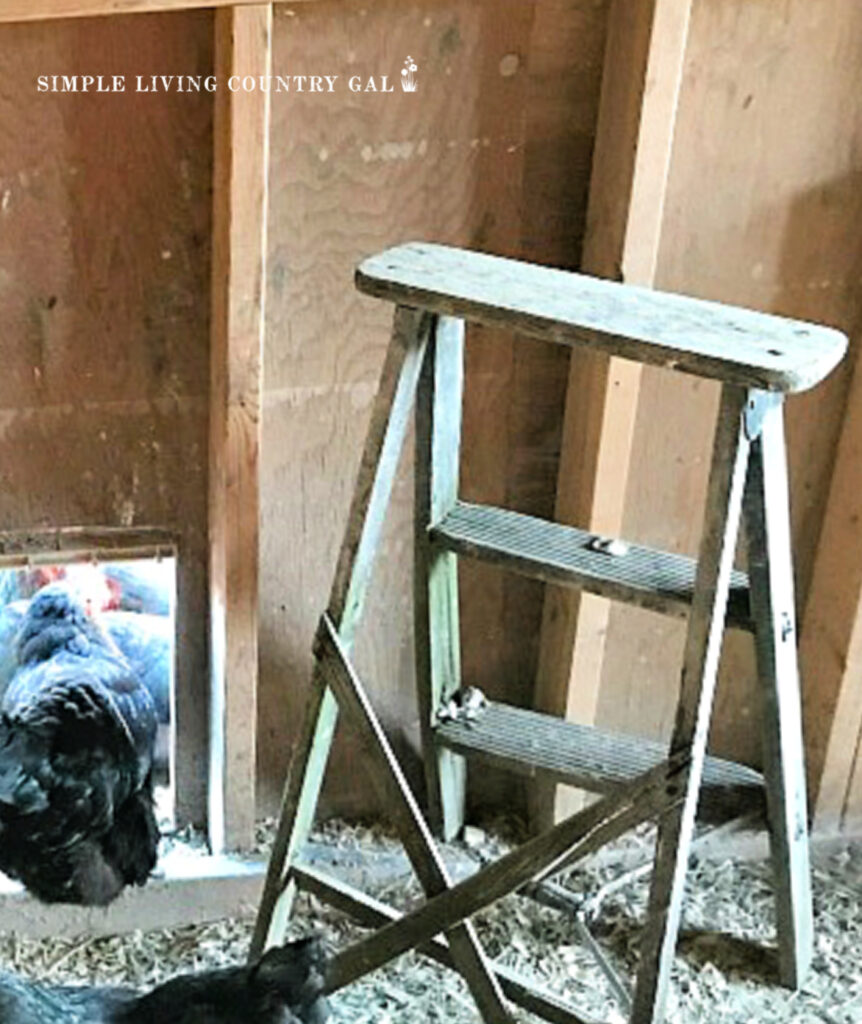






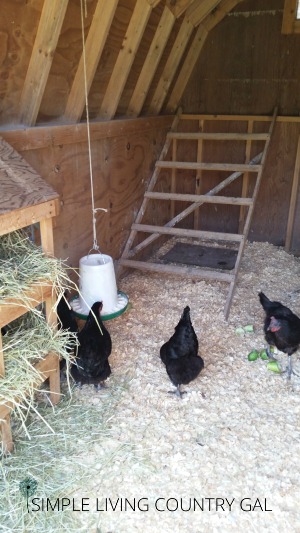
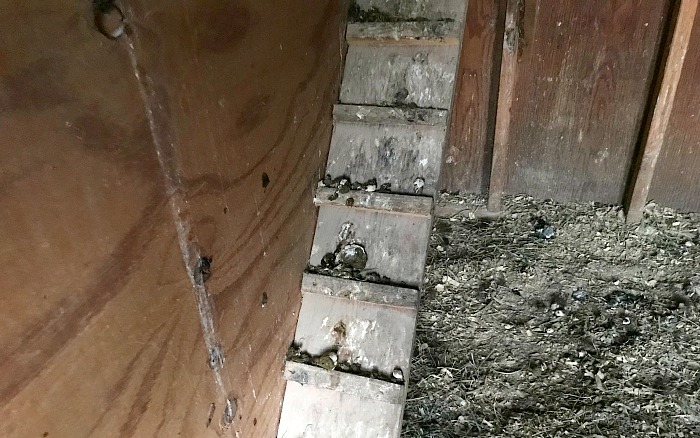
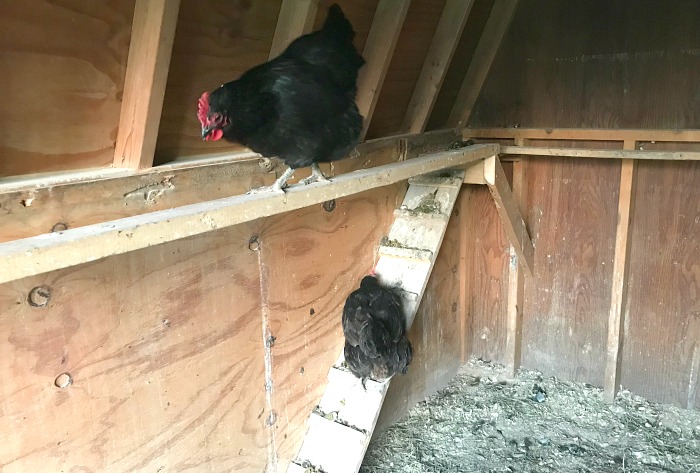
Thanks Tracy Lynn. I love this style roosting bar. I need to find a good place to add another roosting bar in my coop for additional chicks someday. I know the established gals probably won’t share! 🙂
What about “How much space per chicken?” or “how wide should the wood be that their feet are on?”
Hello Tara,
You know what? You are absolutely right! I went back in a added the missing info along with some other useful information. I am so glad you pointed it out to me.
Have a wonderful day!
Tracy Lynn
This is a good post and thoughtful to the chicken. Although, I recommend a step (hop) ladder (3 steps, 12 inch wide, 32 inches high) that leads up to a lower run ( 10 inch jump) 4 inch wide (for walking along so they can decide where they fit on the higher run and or where they can wait in line) The higher run (a step higher), where they will sleep. You could also hang a mesh cradle from the run to collect droppings and scrape droppings off the run each night when putting them to bed. You can slip a garden tray with mesh under the step ladder so there is no droppings they would walk in. Chickens like clean feet and they like to cover their feet under their feathers when they sleep, to keep warm and per instinct ( rodents don’t bite their toes) Offer a two inch depth run vs a 4 inch depth run and they will choose the 2 inch. If you hang a curtain valance right above the run 8 to 12 inches from the wall…they will love dipping their head under the valance and snuggling down with just their behinds poking through. the valance drapes over their body like a skirt. They prefer facing the wall as a warmer gathering place in cold weather when they have a curtain. And of course always use sand for the flooring on cement block. Don’t keep water in the henhouse it will spill and cause mildew, but make sure you get up with the chickens so they can drink and eat first thing in the morning.
These are all really great tips and most work well especially in smaller coops. For us, not having access to water 24/7 is not an option with our large flock. By using a rubber water bowl that is raised up and still weighted down, spilling does not happen. Also, I do agree with the different heights and the wide size of the roost surface. So many folks believe chickens prefer rods to roost on and that simply is not true. They like to be flat-footed and for that reason, a wider board is a better option. The curtain is a cute idea and would again be great for a smaller coop with fewer birds.
Tracy Lynn
Hi!
What is that metal bar called that y’all used to hold the roost to the side of the coop? I’ve been looking for something like that but don’t know what to search.
Thank you!
Hey, Bee!
That is called an L Bracket.
How big of an L bracket? Trying to decide how much space from the wall they need. Thanks!
The L bracket we used was 12 inches.
How much head run do you need for chickens on a roost?
I know it varies with type of chicken, but say red island red?
Hello, Sonya!
I am assuming when you say “head run” you mean space for each chicken on the roost itself? If that is correct, then the answer is 6-10 inches per chicken.
I hope this helps
Tracy Lynn
Great post on DIY chicken roosts! I’m curious, how much time did it take you to complete the project?
I love the hay bales, but how do you keep them clean. Seems they would stay covered with poop!
I’m a new chicken “mama”. The amt of poop was absolutely amazing!!
Yes, there is lots of poo with chickens, right?!
To help, I put small boards under the roost and clean those off into my compost bin each morning. This really helps to keep things cleaner longer. As for the bales, I rotate them until winter is over. In the spring they go into my compost bin.
Tracy Lynn
I read this and found two of the three things I was looking for about the roosting bar. Thank you for providing such detailed into.
The two of my three concerns you addressed were head height (6-10″) bar width (3-4″) but the the third “dimension” I did not find was how far off the wall should the roost be if using flat lumber or 2×4 on edge using “L” bracket or other support be?
Thank you,
Joe
I believe we used a 7″ bracket, and we raise larger birds, and this size worked just fine for our setup.
Loved reading your article. it was really informational for me. wish to see more in the coming days.